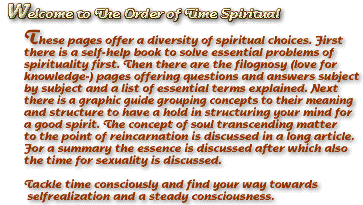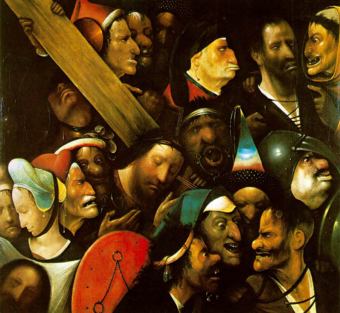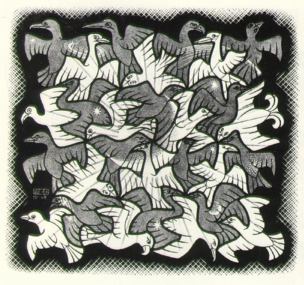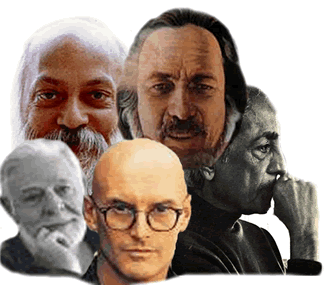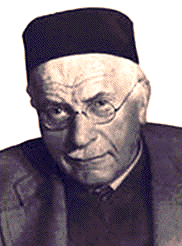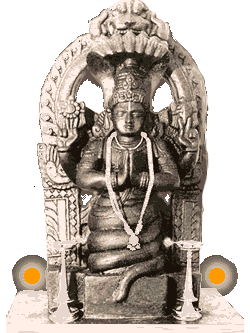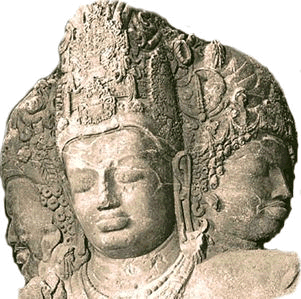Section
IIb: spirituality Combinations:
parcels and
parts, We
analytically saw that the idea
of God
in the form of the factor of
time in
relation to the ether plays a
part in this. The time of the
ego some moment is over and
the time of the more sacred I
of the soul is found
next then. The Muslims do it
on fridays, the Jews on
saturdays and the Christians
on sundays. They reserve time
for the soul and thus show
that the day of rest, or the
day of study to reiterate the
holy book with song and
prayer, is indispensable as a
necessary counterweight to the
karmically being entangled in
a society of accomplishments.
But now we have two approaches
in this drive for purifying
the motives. Firstly there
is the, with the principles
put first, spiritual
contemplating of the essence.
It is, in its philosophically
by Aristotle in his Analytica
Posteriora
being defined as: 'that
what is fundamental,
typical, qualifying and of a
general value to something
else' or lexically
stated more simple is
'essential and indispensable',
linguistically not all too
precise being described, as
something that remains
ethereal, because that essence
may adopt so many forms with
so many methods. Secondly one
has the 'less on itself'
directed religiosity in the
sense of being of a common
contemplation based on rituals
and formalized services, we
normally call religion. The
two camps, the spiritual
people and the religious
souls, have the propensity to
decry each other as being of
illusion. The religion in that
dispute would be too much bent
upon the outer form, or be too
hypocritically or
sanctimoniously of a false
authority in the eyes of the
'ethereal' souls, and
spirituality , in its
independence, would be a dead
end street and a form of
conceit that would be selfish
and, just because of a liberal
'emptiness', be leading to
godlessness and sin in the
eyes of the 'believers'. The
hypocrites flee from the
self-confrontation and the
ethereal souls flee from the
responsibility, so it seems to
be, thus
being
divided. But analytically we
already learned from Freud
that there is something like
projection. The pot blames the
kettle for being black.
Apparently one tries to
separate something, to
distance oneself from
something, from which one
cannot separate oneself. The
holiness of the ethereal souls
depending on some rules, only
of concern to the essence, and
the togetherness of the
believers, deriving from the
together-one-is-stronger
principle of being tolerant
with the weaknesses one
happens to have with those
rules, together point the way
to a like-mindedness with the
sacredness, which is both of
respect for a certain
regularity of contemplation
and for a certain freedom from
being time-bound. This
combination of responsibility
and self-confrontation is what
our filognosy is aiming at. The
religious perspective is
further characterized by its
focus on one specific person:
the person one reveres. One
prays to Krishna as the hero,
Jesus as the lamb, Mohammed as
the prophet, or the Buddha as
the one teacher of
enlightenment. The 'new-agers'
or the people of the New Time,
also called the New Man by the
meditation guru Osho
(previously Bhagavān
S'rī Rajneesh,
1931 - 1990), who is
the godfather of our modern
self-inquiring spirituality,
are, on the contrary, not
specifically focussed on one
person: Osho himself is, as
far as they are concerned, but
a comedian and a friend in
self-realization, whom one
must not take too seriously.
The dutchman Amrito, the
ex-psychiatrist
(Not-Made-of-Wood) Jan
Foudraine, spoke, also to the
instance of the guru Jiddu
Krishnamurti, of master,
anti-master en
psychotherapist: one sometimes
needs a psychotherapist to
learn from the master that
there is no need for a master. As for
time, the spiritualists,
without too much of a
conviction, tend to sun- and
moon worship, as also to
astrological meditations of an
interplanetary time indication
relative to a non-astronomical
celestial sky. Completely
timeless are they not thus,
and for some time one may very
well follow a course, therapy
or group with them. Of the
believers the
Christians e.g. are, on the
other hand, also not so very
fond of the time factor, as
evidenced by the words of
apostle Paul, who would not
want to have that aspect
prevail over the love for
one's fellow man, and the
words of Augustine
of Hippo (354
- 430 A.D.) who had not much
of a heart for the subject
either. Islam on its turn,
fanatic as it may be
concerning the times of
prayer, is not very motivated
either in defining the fridays
of its gatherings to
the nature of the sun and
the moon,
and is
neither really to the point in
the philosophy
of
the
commercial time of
their normal working hours. As
different and contradictory
one thus is with the idea of
time, with a certain freedom
from being bound to the
natural order of time as
opposed to a type of
compromising certainty to the
political nature of standard
time, both positions of
contemplation are still to be
recognized as being part of
one and the same evolution, of
one and the same emancipation
process, in which the soul
finds its purification in
relation to the force field of
the ether. The spiritualists
are, being more gnostic than
the religious souls, more bent
upon the philosophical
explanation of religious
truths, and with that also
more creative and more
personally focussed on the
impersonal of the rules and
principles of that freedom
alone: the freedom of
realization which then,
eventually with a fixed
agreement on time, may result
in a new order or religion in
which one, some way or another,
for the sake of God talks to
oneself - or prays - and in
another way upholds and
remembers the honor of it in
respect of a certain holy
scripture. And that hoping for
the better is also the idea of
being ambitious one likes to
cherish spiritually: the
spirituality, as born from
discontent, disappointment and
powerlessness with the
existing religious and
societal order, has thus also
the function of operating for
the sake of preparing for
either the extant or else a
newer or renewed sense of
functioning spiritually and
societally. With the
perfection of our causal
illusion reasoning from this
section to the - more on the
person oriented - next
section, we first of all will
be dealing with the 'ethereal
types' we predominantly know
by the grace of a certain form
of relativizing the concept
of 'rules'. Simply
stated it is the practical
interest of the spiritual man
to arrive systematically,
under the lead of a couple of
basic principles like
nonviolence and truthfulness,
step by step at an, as said,
alternative consciousness of
time: the third order of the time
experienced.
That inward directed search
for a stable absorption in the
integrity of the true self is
in India simply called yoga
or, literally translated from
the Sanskrit: to link oneself
up (with the soul). The
word god and the word order
for a long time are, up to the
last phase of wisdom and
maintenance, exchangeable and
it is also in this phase of
preservation that the personal
nature of being of service to
this ideal finally floats
atop: the svarūpa,
thus says Lord Kapila to his
mother: 'I explained to
you the four divisions [to the
modes
and the transcendence above
it *]
of identity [svarūpa]
in devotional service as
also the imperceptible of
the movement of time [the
conditioning] that drives
the living entities. For the
living entity there are many
courses of material action
in ignorance, resulting from
working for a material
outcome [karma] my dear
mother, of which the soul
entering that existence does
not understand his own ways.
(S.B. 3.32:
37-38).
Lord Krishna about this says
to Uddhava: 'Just as
someone blinded by liquor is
unaware of the clothes he
wears is the one of
perfection, you see, not
watching the perishable
material body sitting or
standing, to God's will
departing or by fate
determined obtaining [a new
body], because he has
achieved his original
position [his svarūpa].
(S.B.11.13:
36).
The svarūpa, the
personal identity with God is
the goal of selfrealization.
And so do we step by step see
the filognosy originating of
the human being who, while
meditating and for his
expression practicing mantras
or prayers, from a knower of
facts evolves into a meditator
and from being a meditator
arrives at the position of a
purified devotee with an
identity and mission of his
own. The
actual question in this
spiritual section is what
consciousness exactly would
be. In the science section
was clarified that nature, in
the cyclic of time, positions
the moon opposite to the sun.
There is something like a
natural consciousness in
opposition with a cultural
consciousness being not that
conscientious with the
external validity of the
chronometer. The fact that the
culture, complete with her
religions, tends to decay into
a false notion of conservatism
with the politics of an order
of time manipulated for the
money, spoils the spiritual
outlook on the traditional
religion as a final purpose of
one's spiritual evolution. The
religion, seeing itself as the
grace for that original sin of
going against nature, stands
with her pious preservation of
that grace also for the
betrayal of that nature she
therewith tries to protect.
The reformer behind the
spiritual man wants it
differently: he is
alternative, a rebel of
reacting against who, as a
persecutor in the court of
God, by the rest of the
society easily is discarded as
an heretic. But evolution
urges on and progress must be
if we, with the political
oppositions in this conflict,
do not want to lapse into
national and international
warfare. With the filognostic
reboot of the mediation in the
love for the knowledge in
this, we return to the Holy
Self we then must learn to
serve with regularity and
order, without directly saying
which religious tradition or
Godhead would rank first in
that practice. Spiritually
keeping matters open we then
know that Self, which is of
consciousness in the midst of
the oppositions of the world
and is characterized by two
more qualities. And these are
the qualities of eternity and
happiness. The spiritualists,
in short, are searching for
that consciousness of the
duality of the time-bound
world, which is durable on the
one hand and gives happiness
on the other. The true self we
know Vedically by the
qualities of sat, cit and
ānanda, or as being
eternal, conscious and
blissful. The eternal, despite
being called timeless, is not
so though, dualistically bound
as one is with having a body.
The aspect of the eternal
consists of - or exists by the
grace of - the lawfulness and
inevitability of the natural
order of time (In the next
section we will list the
quotations thereto). That is
what makes consciousness
stable, sacred, divine and
ethereal, and offers
recollection; that is what
makes consciousness real as
the second quality of the
knowing self. We are not so
much aware of that true self
as a consequence of opposing
dates with the days of the
week on the basis of an
ulterior profit motive, we are
rather aware of that self on
the basis of that durability
of the, by natural laws
controlled, material reality The
timelessness of the spiritual
for itself is thus an
illusion, as good as a certain
materially oriented
consciousness of time is,
thinking to keep existing for
itself. The stability is found
in one's arriving at the most
personal balance in this, in
one's most personally
conquering of also the human
weaknesses that obscure the
consciousness, in the
creating, or better said
discovering, of a certain
order and discipline and in
the preserving and fitting in
of that order in the, by
nature and tradition, already
existing and maintained order.
And also this course upwards
in the direction of an
aligning of oneself with the
soul in a wider perspective is
thus, when only understood a
linear fashion, as
we already saw, on
itself also an illusion. The
stages of meditation in the ashthānga
yoga of
especially B.
K. S. Iyengar in
the West are also by its adherents
not seen as strictly linear, but
more as a lotus flower of
mutually overlapping and
interacting spiritual petals
or limbs (angas). Only
when the course 'upwards' in
the direction of the abstract
of God equals a course
'downwards' in the sense of a
concrete form of respect for
one's fellow man in which the
holiness, the wisdom, all the
talents, the wealth and the
solidarity all blend
harmoniously, there is the
completeness of the human
being, as envisioned by our
filognosy with her
scientific love for the facts
of the universe, the
principles of the spirit and
the politics concerning the
person. For
the spiritual department we
thus have a different
emphasis: from being
structurally involved in a
scientific sense one gets
involved on principle. The
concrete question rising is
how the discipline of that
alternative time consciousness
then practically would look.
Thus there are no tables
anymore of a structure of
time, but behavioral
directions, discussions of
principles, estimations of
value and graphical
presentations.
Thus we have an
encyclopedically arranged
selfhelp section, as
good as a separate book, named
'The
Other Rules',
which divides the different
limbs of transcending for the
sake of a happier self in
eight sections concerning
daily life, business, dates,
relations, being married,
sports, matters of the body
and being sexual, associated
with the eight angas
of the yoga as mentioned. Next
there are the chapters on the
idea of reincarnation
relating to a certain fear
of time,
what exactly the essence of
spirituality is, what
the relation of our subject
with the
sexual is,
how precisely the filognosy
dialectically sounds like in
spiritual terms, and
what, in the sense of an integral outline
of the different divisions of
concepts, her factual
structure is. * The four
identities to the modes and
the transcendence are known as
the the
Game of Order the human being
plays in his identity of functioning
with a certain experience
in respect of
the four classes, four
statuses, the three modes and
the eight levels of
transcendence. Pictures: The
painting with Jesus is of Hieronymus
Bosch. It is called Christ
carries the cross and
dates from 1485-1490, oil on
panel 76.7 x 83.5 cm. and can
be found in the Musée des
Beaux-Arts in Gent, Belgium. The
etching with the birds is of
M.C. Escher. It is a woodcut
printed from four blocks, and
is titled Sun and Moon.
It dates from 1945 and
measures 25.1 x 27 cm. The
portraits of the
transcendentalists are,
upper-left to right of: Osho,
Jan Foudraine, middle: Alan
watts and Ken Wilber and at
the right in profile J.
Krishnamurti. The man
carrying the fez is the
analytical psychologist Carl
Gustaf Jung. The
statue underneath represents
Patańjali with the body of a
snake because he is considered
to be an incarnation of Adi
S'esha or Sankarshana. The
statue with the three heads is
a so-called trimūrti from
India, showing the three gods
S'iva,
Brahmā en Vishnu as one. The
picture with the Ohm sign in
it is a sundial pictured as a
representation of the will of
God. The
picture with the colored
fields is a graphical
representation of the
interwoven levels of
transcendence that are
discussed in the Other Rules according the
subjects in the fields
indicated.

|
|||||||||||||||||||||||||||||||||||||||
The Other Rules (free E-book)| Filognosy & Terms| Filognostic Guide|Reincarnation & Time|The Essence|Time for Sex | Terms



